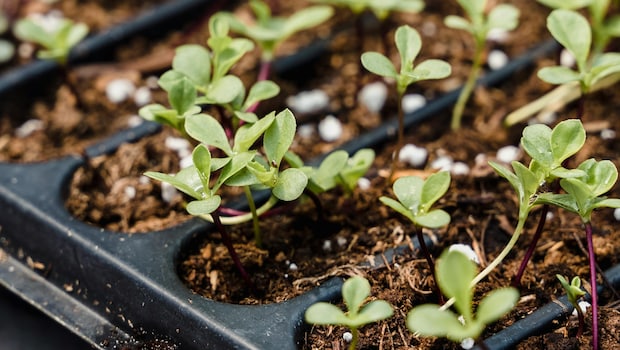Health trends come and go faster than you can say "gluten-free", but microgreens? They are sticking around. These tiny, flavour-packed greens have quietly crept from fancy restaurant plates to home kitchens and Instagram feeds. Compact, colourful, and loaded with nutrients, microgreens are being celebrated not just for their looks but for their serious health cred. But what are they, really? And why are people growing them in their kitchens?
Microgreens are young edible greens - think baby versions of herbs and veggies - harvested right after their first leaves show up. Unlike sprouts, which are grown in water and eaten root and all, microgreens are grown in soil (or tissue), and you only eat the bit above the root. The best part? You can grow them at home. No garden. No complicated equipment. Just a sunny window, a shallow tray, and a tiny bit of patience. Your kitchen shelf is now a mini farm.
Also Read: Move Over Methi Saag. Add Methi Shoots To Your Diet And Enjoy The Goodness
What Are Microgreens? Nutrition, Uses, and Benefits Explained
Microgreens are basically baby plants-just 1-3 inches tall-snipped before they fully mature. Grown from seeds like mustard, methi (fenugreek), dhania (coriander), spinach, chia, flaxseed, and even wheatgrass, they pack a punch in terms of flavour, colour, and nutrition. Do not mistake them for just a garnish-chefs, nutritionists, and serious home cooks are all fans. And for good reason.
Health Benefits Of Microgreens: Why They Are a Superfood
A study by Pennsylvania State University breaks it down: microgreens are stacked with nutrients. Think:
- Dietary fibre
- Vitamins A (pro), C, E, K, and B6
- Folate, thiamin, niacin, choline
- Potassium, iron, zinc, copper, magnesium, manganese
Also Read: Cooking Hack: 6 Simple Tips To Keep Sprouts Fresh For Longer

Photo Credit: Pexels
Here Are 6 Health Benefits Of Eating Microgreens
The journal Molecules highlights some incredible health benefits of adding microgreens to our daily diet.
1. Microgreens for Heart Health: How They May Reduce Risk of Disease?
Microgreens are rich in polyphenols - potent plant-based antioxidants that help neutralise harmful free radicals in the body. These compounds have been linked to improved blood vessel function and reduced blood pressure, both of which support long-term heart health and lower the risk of cardiovascular disease.
2. Can Microgreens Help With Weight Loss and Inflammation?
Loaded with fibre and essential nutrients but low in calories, microgreens can help keep you fuller for longer, which may support healthy weight management. At the same time, their anti-inflammatory compounds work behind the scenes to calm internal inflammation linked to weight gain and metabolic issues.
3. Microgreens and Diabetes: Do They Help Control Blood Sugar?
Several studies suggest that the antioxidants in microgreens may help improve how the body uses insulin. By reducing oxidative stress and enhancing insulin sensitivity, these tiny greens could play a role in stabilising blood sugar levels, especially when paired with a balanced diet.
4. Are Microgreens Good for Kidney Health? What Studies Say
Microgreens tick several boxes for kidney-friendly foods: they are low in sodium, high in potassium, and packed with antioxidants. This combination supports healthy fluid balance and helps ease the load on your kidneys, especially important for people watching their blood pressure or managing early-stage kidney conditions.
5. Anti-Inflammatory Benefits of Microgreens You Should Know
Polyphenols do not just sound fancy - they actively fight chronic Polyphenols in microgreens help fight chronic inflammation by neutralising stress-inducing free radicals that can damage tissues over time. This makes them a powerful addition for people managing conditions like arthritis, gut issues, or even general fatigue linked to inflammation in the body.
6. Do Microgreens Help With Iron Deficiency and Low Haemoglobin?
Microgreens like spinach, fenugreek and amaranth are naturally high in iron and also contain vitamin C and other compounds that improve iron absorption. Regularly adding them to meals may help boost haemoglobin levels and reduce the risk of anaemia, especially for vegetarians.

Photo Credit: Pexels
How To Grow Microgreens At Home: Step-By-Step Guide For Beginners
You do not need a green thumb - just a small tray and some light. Here is how we did it:
You Will Need:
- Seeds of your choice
- A shallow container (we used a clay tray)
- Growing medium (we used layers of organic tissue paper)
- A spray bottle
- A sunny spot near a window
Steps:
- Lightly wet your tray using the spray bottle.
- Add your growing medium.
- Scatter the seeds evenly and press them in lightly.
- Mist with water.
- Cover with a lid or cloth for a couple of days.
- Once they sprout, remove the cover and place the tray in sunlight.
- Mist 2-3 times daily.
- In 7-10 days, snip just above the medium-and they are ready to eat.
Microgreens Growing Tips: Mistakes to Avoid for Healthy Greens
- Use clean, food-safe containers to keep things hygienic.
- Do not drown your greens-overwatering can lead to fungal issues.
- Airflow is key - ventilation keeps mould away.
- Wash thoroughly before eating, especially if grown in soil.
Microgreens are the kind of food trend we do not mind hopping on-tiny, tasty, and genuinely good for you. Throw them on your dal-chawal, stir them into sabzi, blend them into a smoothie, or just toss them into a salad. They lift the plate, and they lift your health game, too.
Go ahead. Grow your own. Your window sill deserves a little life.
About Somdatta SahaExplorer- this is what Somdatta likes to call herself. Be it in terms of food, people or places, all she craves for is to know the unknown. A simple aglio olio pasta or daal-chawal and a good movie can make her day.









